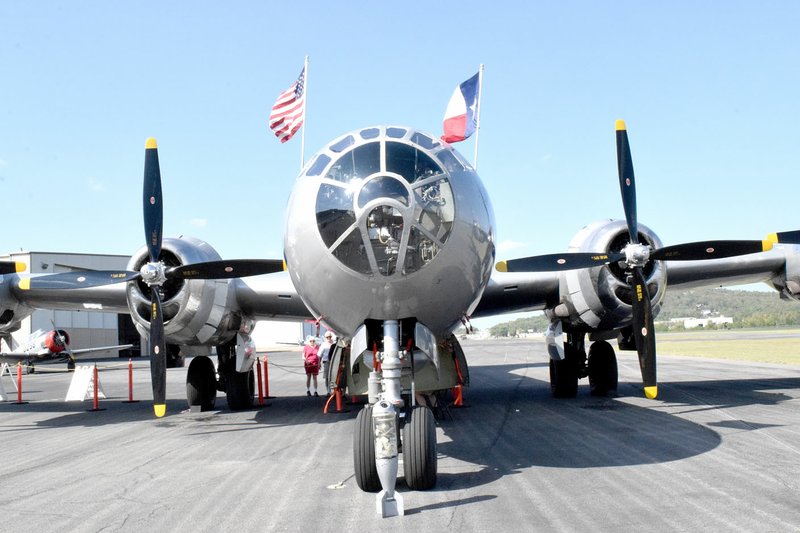DECATUR — "What was that big airplane that D.K. flew over Decatur several years ago?" asked a longtime resident of Decatur who remembered the event as if it happened only yesterday. The answer: a B-29 World War II bomber.
On May 24, 1993, Decatur was rocked by the sounds of a large aircraft flying low over Main Street. At the controls was one of Decatur's most memorable residents, Donald Kevin Bredehoeft, known to his friends as D.K.
The Boeing B-29 Superfortress affectionately known as "FIFI" was at the Arkansas Air and Military Museum at Drake Field in Fayetteville Sept. 19-25, wrapping up a six-month national tour before heading to its Dallas (Texas) home.
"FIFI" is one of only two flying B-29s in the world. The second, known as "Doc," is based in Wichita, Kan.
The B-29 was one of the most recognizable bomber aircraft in the Pacific Theater of WWII. The Superfortress prototype made its first flight on Sept. 21, 1942, over Wichita. A few months later, the B-29 went into production. In all, 3,900 aircraft were produced from 1943 to 1945.
"FIFI" was relegated to the boneyard at the Naval Weapons Center at China Lake, Calif., in the mid-1950s. Several years later, a group of volunteers committed to finding and restoring the very aircraft that won WWII went on a quest to find a B-29 to put back into the air. Government officials directed the group to China Lake where several old bombers were stored.
Volunteers from the Confederate Air Force flew to the California to look for an aircraft. Of the dozens of hulks at the base, the plane that would eventually be named "FIFI" was the best preserved. The group ran up against the usual government red tape for several months until help from an unlikely source secured the release of that aircraft. A former senator from Arizona, Barry Goldwater, heard of the struggle an intervened on the group's behave.
In March of 1971, the aircraft was finally released to CAF. After scavenging parts from other aircraft, "FIFI" was restored enough to get her home. On August 3, 1971, "FIFI" took off from China Lake on a ferry flight to Harlingen, Texas, CAF's headquarters. After a three-year restoration, the B-29 flew in her first airshow, thus beginning a long career as a flying museum.
However, in 2006, the B-29/B-24 squadron of CAF found itself without the services of the "Queen of the Skies" when a series of engine failures prompted the grounding of "FIFI." After years of uncertainty about her future, the squadron found a new set of modified Wright 3350-95W engines, and she was back in service on Aug. 5, 2010, some 39 years after she flew from China Lake. "FIFI" continues to tour the country for the Commemorative Air Force in remembrance of all those who gave their lives in the name of freedom.
Back to that fateful day in 1993, "FIFI" was on her way to Drake Field in Fayetteville from her previous stop in Tulsa, Okla. At the controls was pilot Dick Markgraf, one of the B-29's principal pilots. Bredehoeft was flying as co-pilot.
Bredehoeft, an experienced pilot, flight engineer and mechanic made a promise to a few of his friends that he would fly the big four-engine bomber down Main Street around 1 p.m. And that is exactly what he did. Markgraf turned control of "FIFI" over to Bredehoeft just north of Gravette. The B-29 turned south and made its Decatur run.
When Bredehoeft spotted Crystal Lake Airport, he dropped the plane to pattern altitude (the exact altitude was not revealed) and entered the initial point (IP) of the bomb run on downtown Decatur.
The town's people were used to trains rumbling through town, but the sound of four Wright Cyclone 18 cylinder R-3350 engines propelling 120,000-plus pounds of aircraft over Decatur was something never before heard there.
Those on the ground looked up and marveled at the beautiful gray bird gleaming in the afternoon sunlight as it flew by.
The B-29 made one more pass before heading toward Fayetteville.
The Boeing B-29 Superfortress FIFI's 2017 stop at Drake Field marked its sixth visit to Northwest Arkansas -- five in Fayetteville and one in Rogers. It continues to serve as a lasting legacy to all the men and women who built, flew and maintained these remarkable machines that helped to end one of the darkest times in history.
General News on 10/04/2017

